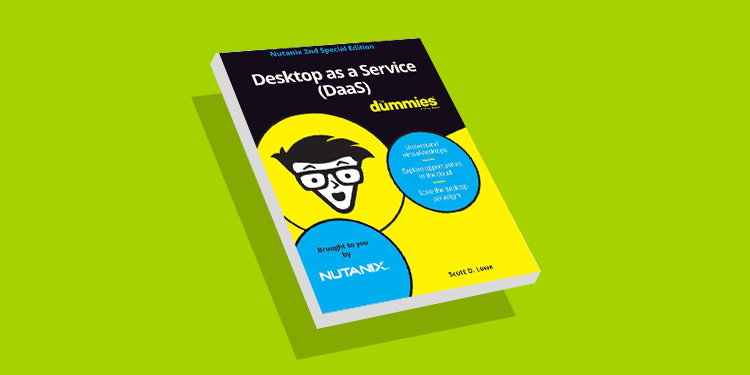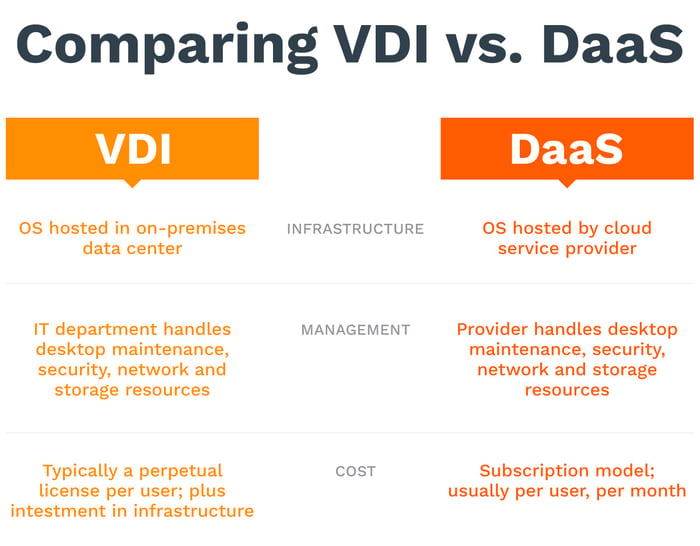The Best Guide To Daas Desktop As A Service
Table of ContentsSome Ideas on Daas Desktop As A Service You Should KnowGetting The Daas Desktop As A Service To WorkDaas Desktop As A Service Fundamentals ExplainedGet This Report on Daas Desktop As A ServiceDaas Desktop As A Service Can Be Fun For Everyone
This framework has already been carried out as well as is presently in prevalent usage by various multi-national business and also individuals across the world. With the rapid advancement of cloud computer and also its paradigms due to the continuous pandemic, Desktop as a Service might play a really vital duty in powering and forming the IT landscape in the future.
Both Desktop as a Solution (Daa, S) and also Digital Desktop Framework (VDI) enable companies to provide virtualized desktop computers and applications to end individuals anytime, anywhere, as well as on any endpoint device. That makes both of them ideal for today's hybrid work settings, where workers work onsite as well as remotely. Which one is much better? In this Daa, S vs VDI post, we'll be discussing the similarities and also differences in between the two, their benefits and negative aspects, as well as last but not the least, the usage cases that each kind of service is ideal matched for - DAAS Desktop as a Service.
Similar to all cloud-based services, Daa, S follows a membership and/or usage-based repayment version. To utilize a shared digital desktop with 2 v, CPU and 8 GB of RAM, a client could have to pay $75 per user per month. Similar to various other cloud-based solutions, in Daa, S, the client does not have to build the underlying framework.
Some Daa, S companies are focused simply on providing Daa, S, the current area of Daa, S companies includes huge cloud companies like Microsoft Azure as well as Amazon.com Internet Solutions (AWS), virtualization business, as well as even smaller sized third events like managed solution suppliers (MSPs) that have included Daa, S to their line of services.
The Ultimate Guide To Daas Desktop As A Service
Client-defined Daa, S provides much more adaptability however also calls for more technical knowledge from the customer. Managed Daa, S is extra like a totally organized offering where the majority of the components behind the solution are handled by the carrier. Typically, client-defined Daa, S is supplied by the huge cloud providers, while managed Daa, S is normally supplied by MSPs, independent software program vendors (ISVs), value-added resellers (VARs), and system integrators (SIs) (DAAS Desktop as a Service).

— Cloud Links (@ldcloudlinks) December 14, 2022
Those that have this ability are easier to have and also manage, as this implementation alternative eliminates the requirement to construct and manage specific parts of the underlying infrastructure (e. g., physical servers, storage systems, networking, and also cooling systems, in addition to hypervisors, to state a few). From the factor of view of completion customer, there are no obvious distinctions between applications and desktop computers provided by Daa, S and those delivered by VDI.

Indicators on Daas Desktop As A Service You Need To Know
These duties are all taken in by the Daa, S company. It's the precise opposite for VDI clients, who must organize all these obligations. As noted previously, there are VDI services that can be released in the cloud. For these implementations, a considerable portion of the infrastructure-related obligations (e.
Nevertheless, release, administration, and maintenance of the VDI control aircraft is maintained by the client. As with all cloud-based solutions, Daa, S costs are based primarily on operating expenses (OPEX). By contrast, VDI costs are based primarily on funding expenditures (CAPEX). This indicates that Daa, S customers are a lot more interested in continuous costs, while VDI clients are more worried about upfront costs.
It's various in a VDI environment released on-premises where, as an example, your IT manager might know exactly which rack your VDI option is working on or which storage space device holds your most private documents. Daa, S settings are much like any type of cloud environmentthey're extremely scalable. You can broaden and also get your fleet of virtual desktops on-demand easily.
Although the VDI remedy itself might be scalable, that scalability can be limited by the underlying physical infrastructure (i. e., physical web servers, storage space systems). Currently that you understand the crucial differences between Daa, S and VDI, let's discuss their benefits, disadvantages, and also the usage instances they're each finest fit for.
The Best Guide To Daas Desktop As A Service

Due to the fact that your Daa, S company takes in a substantial part of the administrative obligations currently, your IT group can take on more critical ventures that add value to your core business. With Daa, S, there's virtually absolutely no ahead of time expense. Because of this low obstacle to access, services can gain the dexterity as well as efficiency benefits of making use of remote applications and also desktop computers rapidly.
Although the bulk of your expenses are focused in the structure phase of your VDI framework, it does not imply you can not sustain additional costs top article later. Some expenses, such as those for equipment substitutes or fixings, can come when you the very least expect them - DAAS Desktop as a Service. In Daa, S's subscription-based billing design, costs are extra predictable.
This can make budgeting simpler. Daas additionally has some negative aspects such as: Although Daa, S providers have network division and information isolation measures in area, the multi-tenant design of Daa, S environments (where numerous companies share the underlying infrastructure) still makes them rather prone to data leakages. This can be created by unexpected and deliberate malpractices such as an overallocation of opportunities by a cloud engineer, a misconfiguration by an organization's cloud administrator, or a destructive lateral activity by a danger actor.
Indicators on Daas Desktop As A Service You Need To Know
A Daa, S atmosphere's OPEX-based expenses indicate you have to deal with ongoing expenses that, in the long run, can end up being more pricey than the in advance costs plus the functional costs of a VDI setting. Due To The Fact That Daa, S environments are run and also provided by the solution provider, you don't have as much control over your electronic assets (e.
Daa, S providers, service providers the specifically cloud providers, suppliers several execute numerous measures that procedures help guarantee the security of safety and security digital assetsElectronic
When an unexpected rise popular asks for mass hiring of momentary employees, it's less complicated to suit those short-term hires with Daa, S Read More Here due to the fact that if a VDI environment's underlying infrastructure is already at maximum capacity, you'll be forced to add more physical servers. What will you finish with those servers when the demand subsides? For Daa, S, it's just a matter of briefly adding more memberships while the requirement exists.